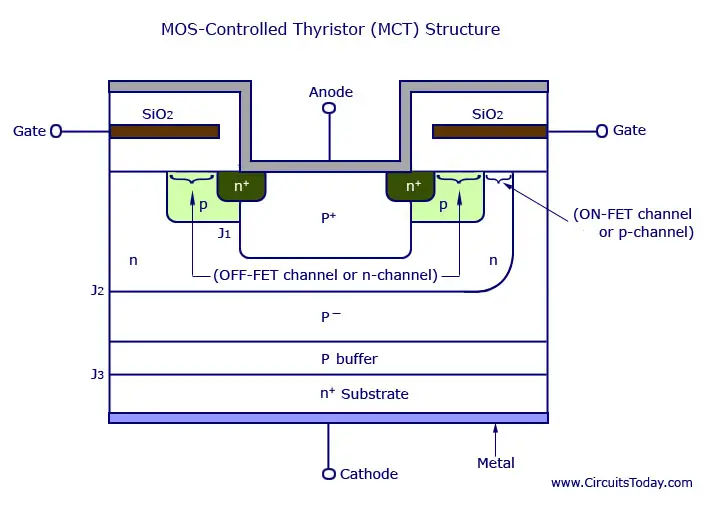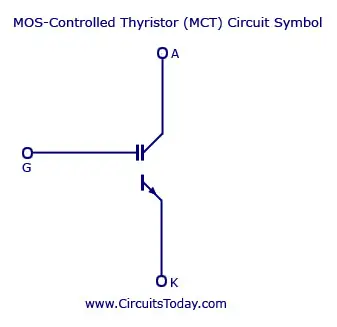Out of many semiconductor controlled
devices, MCT is considered to be the latest. The device is basically a
thyristor with two MOSFET’s built into the gate structure. A MOSFET is
used for turning ON the MCT and another one is used for turning it OFF.
The device is mostly used for switching applications and has other
characteristics like high frequency, high power, and low conduction drop
and so on. An MCT combines the feature of both conventional four layer thyristor
having regenerative action and MOS- gate structure. In this device, all
the gate signals are applied with respect to anode, which is kept as
the reference. In a normally used SCR, cathode is kept as the reference terminal for gate signals.
The basic structure of an MCT cell is shown in the figure below.
In practice, a MCT will include thousands of these basic cells connected in parallel, just like a PMOSFET. This helps in obtaining a high current carrying capacity for the device.
The equivalent circuit of the MCT is shown in the figure below.
It consists of an ON-FET, an OFF-FET and
two transistors. The MOS structure of the MCT is represented in the
equivalent circuit. It consists of one ON-FET, a p-channel MOSFET, and
an OFF-FET. Both n-p-n and p-n-p transistors are joined together to
represent the n-p-n-p structure of MCT. An n-channel MOSFET is
represented by drawing the arrow towards the gate terminal. A p-channel
MOSFET is indicated by drawing the arrow away from the gate terminal.
The two transistors in the equivalent circuit indicate that there is
regenerative feedback in the MCT just as it is an ordinary thyristor.
The circuit symbol of MCT is shown below.
Turning ON Process
The device is turned ON by a negative
voltage pulse at the gate with respect to the anode. For turning ON MCT,
gate is made negative with respect to anode by the voltage pulse
between gate and anode. So, MCT must be initially forward biased, and
then only a negative voltage be applied. With the application of this
negative voltage pulse, ON-FET gets turned ON whereas OFF-FET is already
OFF. With ON-FET ON, current begins to flow from anode A, through
ON-FET and then as the base current and emitter of n-p-n transistor and
then to cathode K. This turns on n-p-n transistor. This causes the
collector current to flow in n-p-n transistor. As OFF FET is OFF, this
collector current of npn transistor acts as the base current of p-n-p
transistor. Subsequently, p-n-p transistor is also turned ON. If both
the transistors are ON, regenerative action of the connection scheme
takes place and the MCT is turned ON.
Turning OFF process
The device is turned OFF by applying a
positive voltage pulse at the gate. The positive voltage pulse causes
the OFF-FET to turn ON and ON-FET to turn OFF. After OFF-FET is turned
ON, emitter based terminals of p-n-p transistor are short circuited by
OFF-FET. So, now anode current begins to flow through OFF-FET and thus
base current of p-n-p transistor begins to decrease. The device has the
disadvantage of reverse voltage blocking capability.
Advantages of MCT
- Low forward conduction drop
- Fast TURN-ON and then OFF times
- Low switching losses
- High gate input impedance





No comments:
Post a Comment